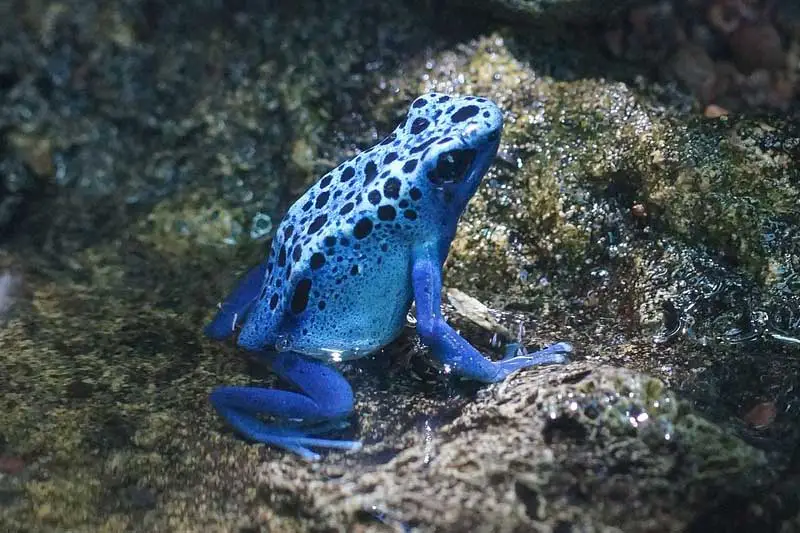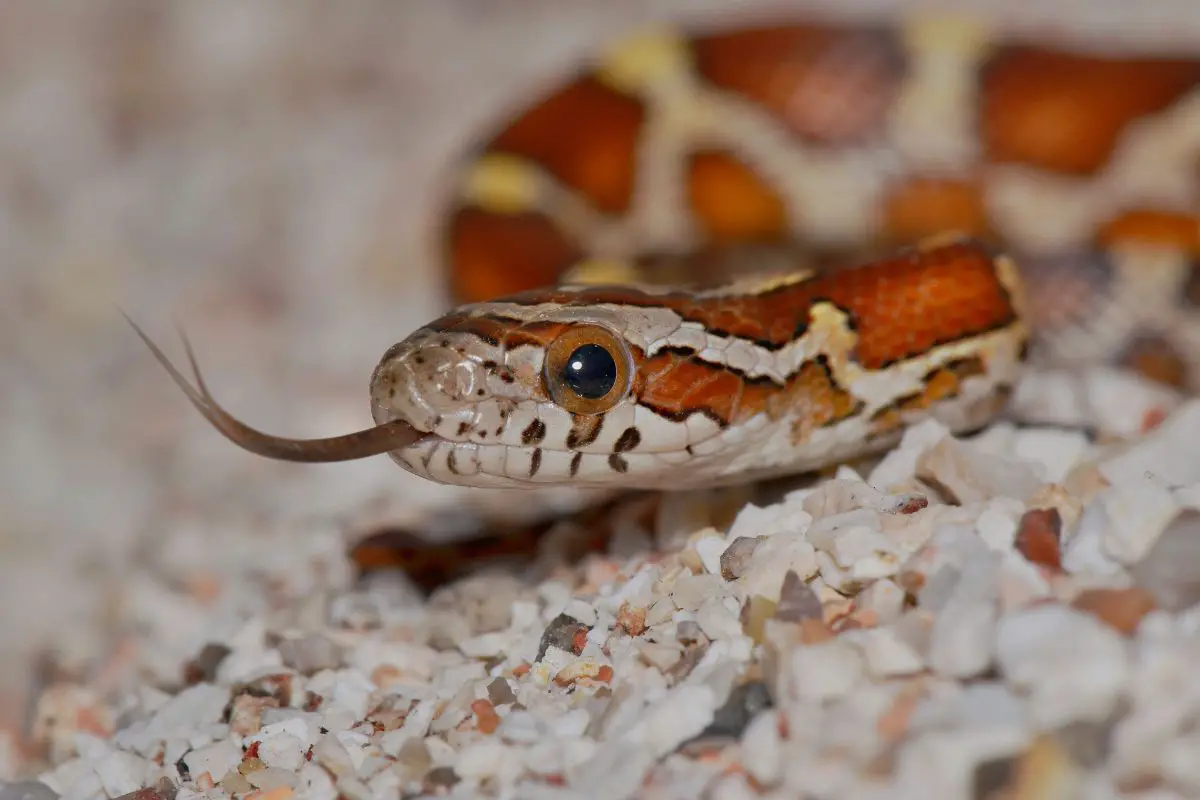Frogs are the most popular pet amphibians, but there are so many to choose from if you looking. Since they are relatively easy to care for and are very cool to look at, their popularity as a pet has grown in recent years. In addition, frogs are known for having fairly long life spans in captivity and are pretty hands-off so it tends to be a win-win for pet owners. Let’s take a look at some of the different types of pet frogs that people keep as pets.
Types of pet frogs
We rounded up 10 common pet frogs and put them in a nice list for you along with some picture and facts about them. Let’s have a look!
1. Pacman Frog
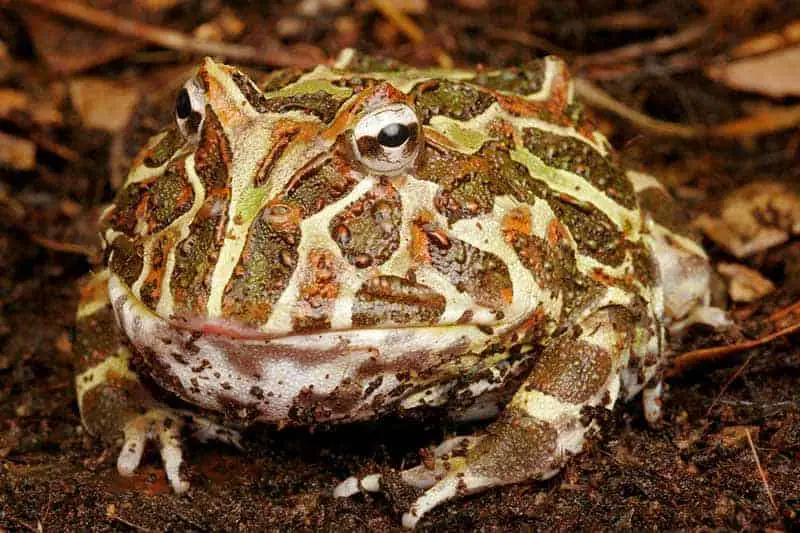
- Scientific name: Ceratophrys ornata
- Adult size: 2-7 inches (male 2-4, female 4-7)
- Care level: easy
When you think of amphibians, you may think of swimming. But Pacman Frogs are not great swimmers. In fact, they like to lounge around in leaf litter eating whatever comes their way, including other frogs so the Pacman Frog is best left alone.
You may also hear the name Pacman Frog and think of the game, and you would be right. The frog is said to resemble the character of Pacman with their big mouths and round appearance. They come in a variety of colors and have distinguished patches on their body.
2. African Dwarf Frog
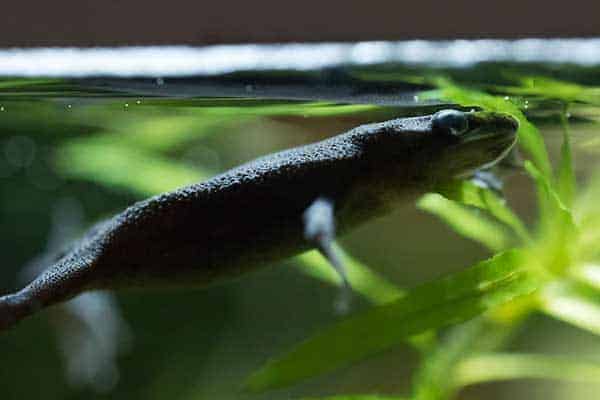
- Scientific name: Hymenochirus
- Adult size: no more than 3 inches
- Care level: intermediate
The African Dwarf Frog, originally from the Congo river basin area, spends nearly all their time under the water. While they do not live long normally, they can die earlier if they are out of the water too long–about 15 minutes.
The best thing to do with these frogs is to leave them in the water and provide lots of places for them to hide through camouflage. This aquatic frog is adverse to being out of the water and will come up only to take a breath. Do not be surprised if you see them shedding their aquatic skin as this is a normal process for the African Dwarf Frog.
3. African Clawed Frog

- Scientific name: Xenopus laevis
- Adult size: 4-5 inches
- Care level: easy
The African Clawed Frog (ACF) are very popular in aquariums. Imported to the U.S. in the 1950’s, they are also found in the wild of the Southwestern states. Often mistaken for African Dwarf Frogs, the African Clawed Frog is larger with non-webbed feet in the front and claws on their back feet.
Like the Dwarf, the African Clawed Frog is an omnivore but will eat other animals and should not have tankmates. The ACF eats their food whole and produces a lot of waste. To keep one as a pet, you must ensure there is proper filtration and the aquarium has good water quality.
4. Amazon Milk Frog
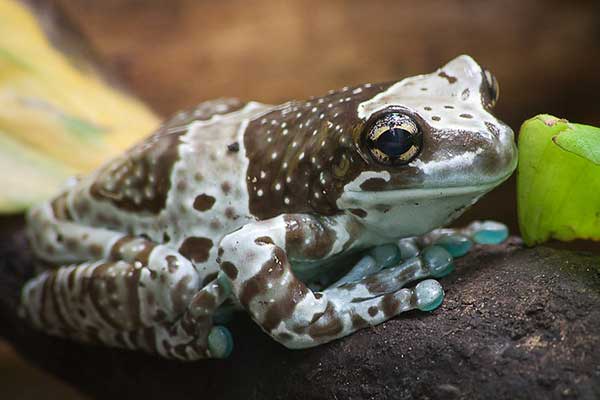
- Scientific name: Trachycephalus resinifictrix
- Adult size: 2.5 – 4 inches
- Care level: easy
Amazon milk frogs, also known as Mission Golden-eyed Tree Frogs, are arboreal which means they spend most of their time in trees. But they also need dechlorinated water changed daily. They usually spend time in tree holes which are filled with water. Having both is crucial to captivity survival.
Amazon milk frogs do well in captivity as long as they are kept in the proper conditions. To keep one of these frogs, they must have the right temperature and humidity, to keep it close to their natural rainforest conditions.
Ideally, Amazon milk frogs would be kept with other frogs, no more than 8. They are extremely social animals and their happiness (and breeding) would be boosted with friends.
5. American Green Tree Frog

- Scientific name: Hyla cinerea
- Adult size: Up to 2 1/2 inches long
- Care level: easy
These bright green tree frogs are the perfect color for hiding among foliage in both the wild and in your terrarium. They are simple frogs to take care of which makes them a popular pet. However, not only is their skin not a fan of human handling, they are not fans. They will squirm their way out of your hands so be careful!
This nocturnal frog is active and vocal at night. They like to hide up in trees but will come lower to eat insects, specifically crickets. Because they do not require much (short of a weekly terrarium cleaning), these are perfect frogs for beginners. However, keep in mind that American Green Tree Frogs have lifespans of less than 5 years.
6. Barking Tree Frogs
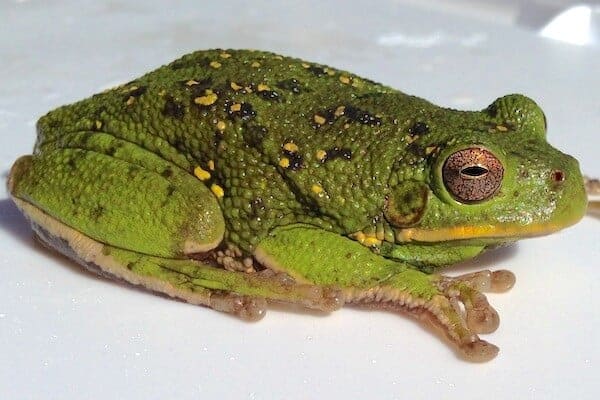
- Scientific name: Hyla gratiosa
- Adult size: 2-2.5 inches
- Care level: easy
Part of the tree frog family, the Barking tree frog gets its name for its call that is strikingly similar to a bark. Besides its call, it is distinguished from others by their bumpy skin texture. Being from Florida, the Barking tree frog needs a 12 hour light cycle and a humidity between 50 and 75%.
These solitary creatures are arboreal in nice temperatures but if it gets too hot, it will burrow down into the ground. To ensure this burrowing is successful, the terrarium should include soft substrate. In captivity, they will need a pond to take a dip and places in which to hide and enjoy some alone time. In addition, in building a terrarium for a Barking tree frog, it is vital that it includes places for the frog to climb.
7. Blue Poison Dart frog
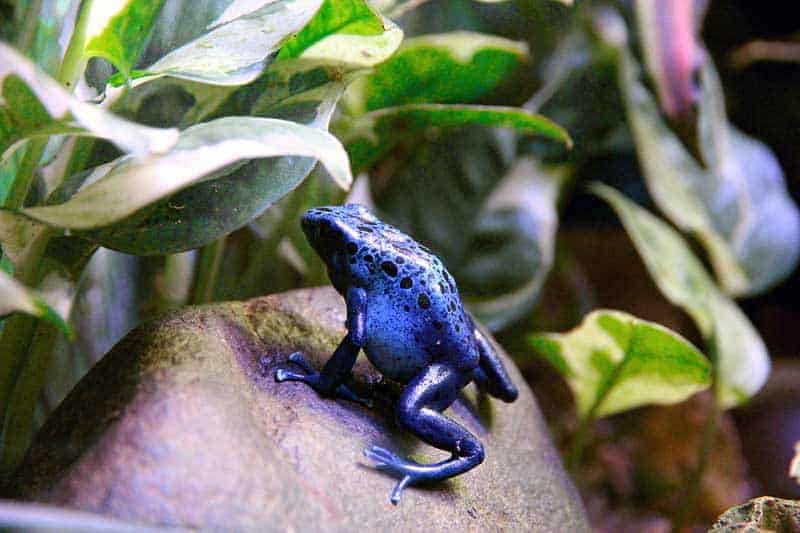
- Scientific name: Dendrobates tinctorius “azureus”
- Adult size: About 1.5 inches
- Care level: easy
If you are looking for an itty-bitty frog with beautiful patterns, the Blue Poison Dart Frog may be for you. This sapphire-colored frog is actually poisonous. The poison comes from the insects they eat as they consume lipophilic alkaloids which allows the Blue Poison Dart Frog to develop toxins on their skin.
However, that toxic skin is not present when the frogs are in captivity. When in captivity, they eat different bugs which do not give them the alkaloids they need to have toxic skin. While you will not be poisoned by touching them, you can in fact die from eating one. While we definitely do not suggest eating one, scientists have found that the skin toxins actually have a horrific taste.
Unlike other frogs, the Blue Poison Dart Frog is not a good swimmer. These frogs prefer to climb up into trees to camouflage. They do not have webbed feet but they do have heart shaped toe tips and suction-cup pads on their feet.
While only discovered in the last five decades, the Blue Poison Dart Frogs are quickly becoming a favorite pet / zoo exhibit, which isn’t always a bad thing. For many years, the population was declining due to pollution, drought, and habitat destruction. In captivity, conservationists have been trying to breed more to boost population.
8. Cuban Tree Frogs
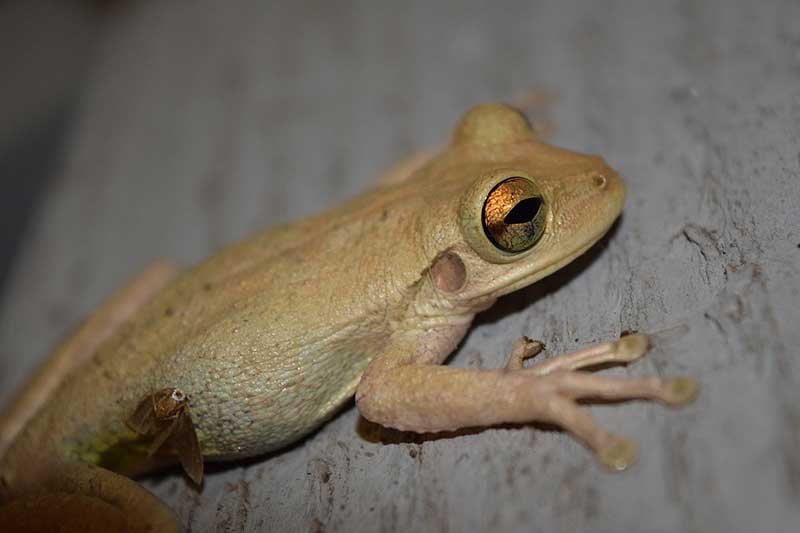
- Scientific name: Osteopilus septentrionalis
- Adult size: 2-5.5 inches
- Care level: easy
The largest of the tree frogs in North America, these frogs have a wart-like skin with the ability to change color to camouflage. This nocturnal frog hides during the day and comes out at dusk to hunt and breed. It is known to eat nearly everything, including other frogs.
While they are not seen during the day, they are still often kept as pets. They can live around 12 years old if cared for properly in captivity. Their adaptability, long life and ability to eat nearly everything make them a pet owner’s favorite. However, like the Poison Dart Frogs, the Cuban Tree Frog has a toxic secretion that comes from their skin. While it will not kill you or your pets, it can certainly cause irritation to skin or eyes so it is best not to handle them.
9. Gray Tree Frogs
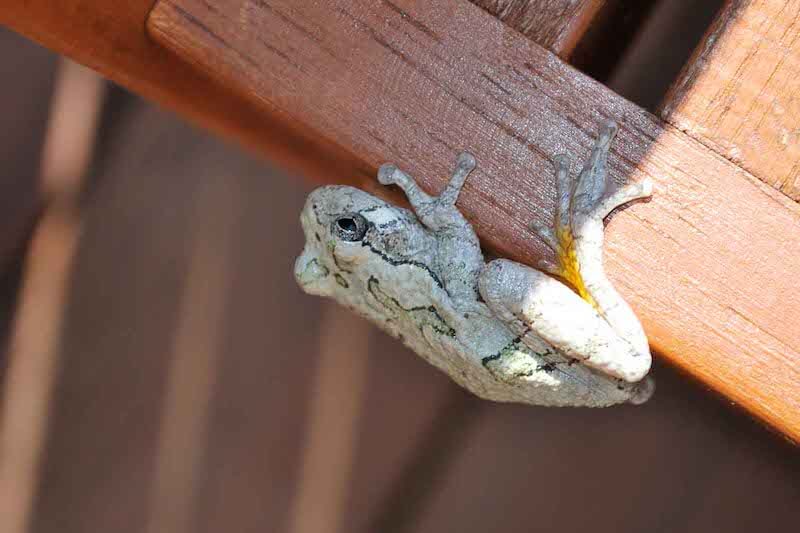
- Scientific name: Hyla versicolor
- Adult size: 1.25-2.5 depending on gender
- Care level: (easy, hard, intermediate)
The name Hyla versicolor means “variable color” because the Gray Tree Frog, despite its name changes based on its environment from gray to brown to green. It’s bumpy skin gives off a look of having lichen for skin but it helps the frog to camouflage. If you decide to keep one as a pet, get a taller aquarium with lots of plants and rocks for your Gray Tree Frog to climb and hide.
The Gray Tree Frog has excellent eyesight and can often be found hopping from tree to tree to hunt for food. One of the things that sets them apart from other frogs is how loud their call is. Usually after dusk, the Gray Tree Frog will musically call frequently and loudly. Keep in mind that if you are looking at this frog for a pet, the call can go on for hours!
10. Pacific Tree Frog
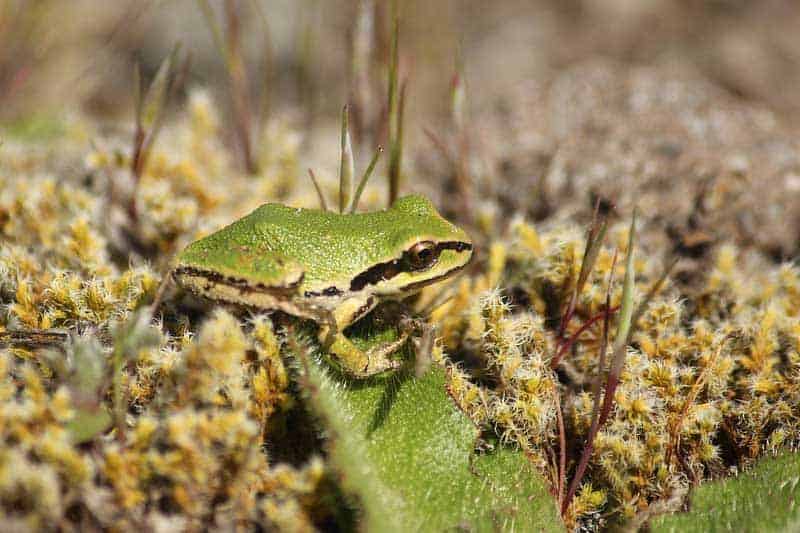
- Scientific name: Pseudacris Regilla
- Adult size: 2 inches
- Care level: easy
If you like a frog that will stay up all night croaking, look no further. The Pacific Tree Frog is a very vocal, nocturnal frog that will do just that. At about 2 inches, this small frog will croak all night attracting females.
It is fairly easy to tell the males and the females apart. The males have a rough patch on their arms and legs which helps them to mate with a female without falling off. Also, the males have a vocal patch/dark patch on their throats and are smaller than the females. But both are able to change colors frequently.
